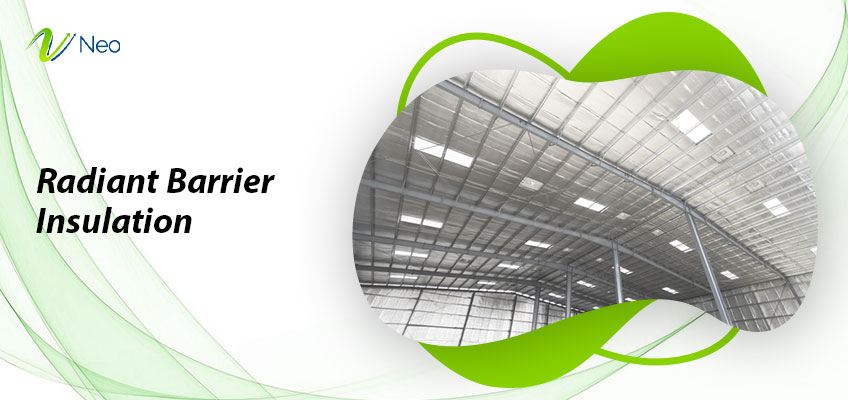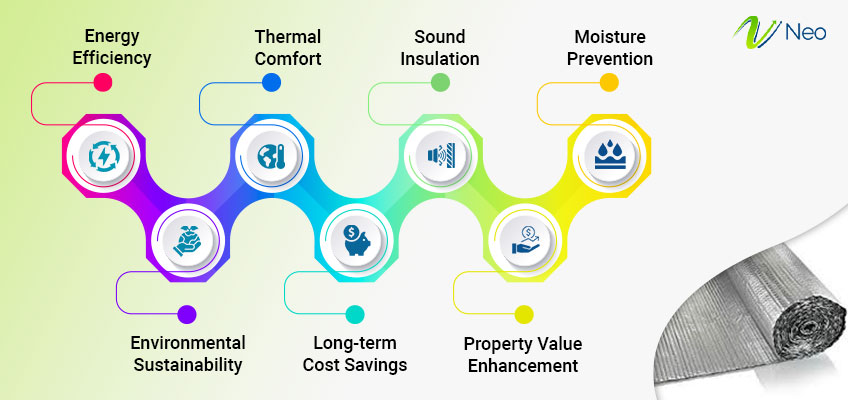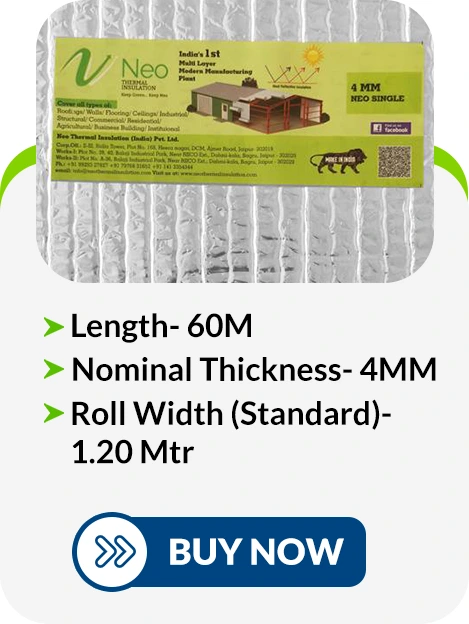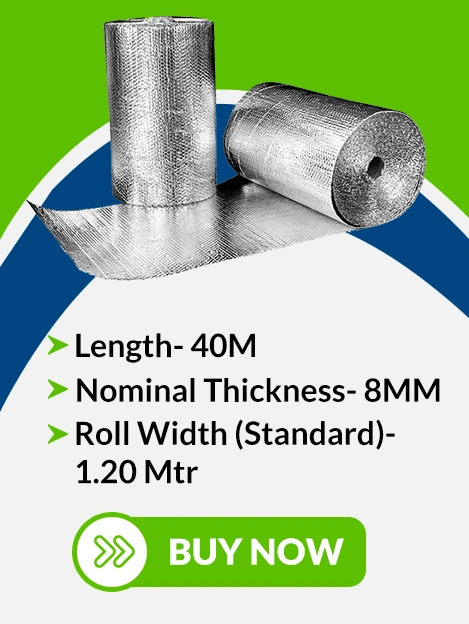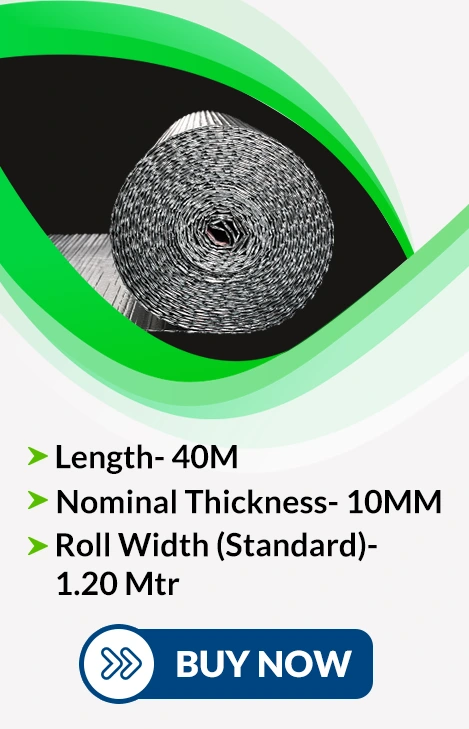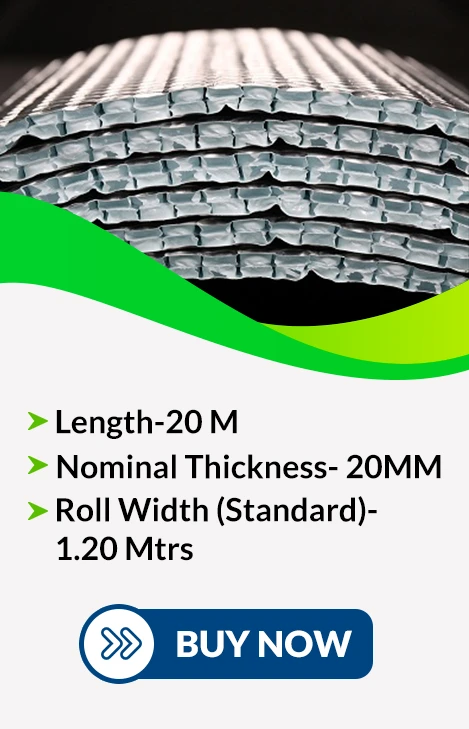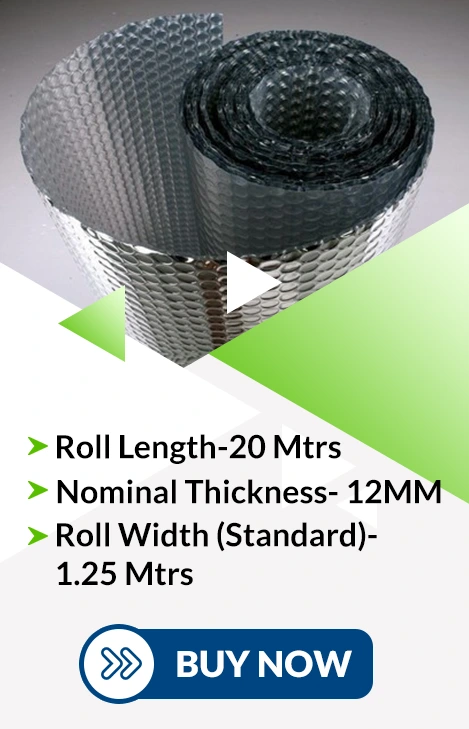Roof Insulation: Types, Cost, Meaning
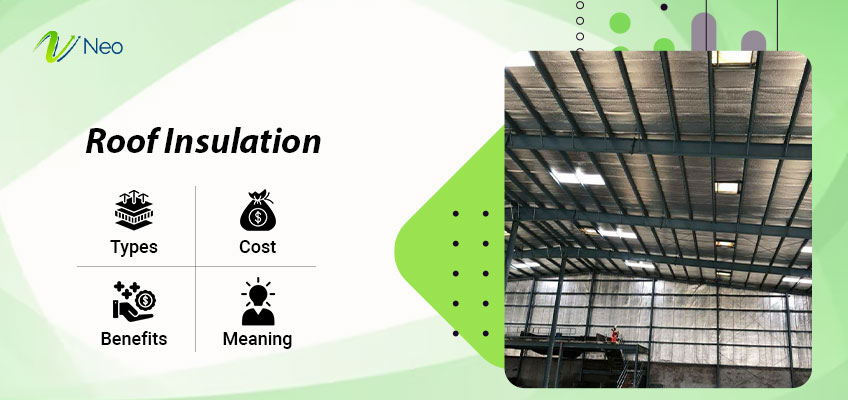
In terms of energy-efficient and green living, roof insulation is a crucial topic. As more homeowners look for ways to improve the comfort of their homes while reducing energy use, in-depth knowledge about roof insulation is critical. The Roof Insulation Market is projected to attain a value of $10.52 billion by 2025, marking a steady growth at a Compound Annual Growth Rate (CAGR) of 3.74% from 2020 to 2025.
This blog dives into the world of roof insulation, discussing its different types and uncovering factors that play a role in determining their price. Roof insulation serves as a sentinel to weather extremes, offering defence for the indoor environment that moderates from the coldest winters through the hottest summers. Unsolving the enigmas behind varied roof insulation types, we travel among their advantages and differences to understand what benefits are exclusive to each type.
In addition, we debunk the cost-related implications that arise from these insulation solutions; focusing on long-term savings and environmental benefits thus making roofing maintain a fine equilibrium of comfort commitments and economic principles as well as insurance at home.
What is Roof Insulation?
Roof insulation is a material or layer placed in the attic of a building to minimize heat flow and control indoor temperature. It acts as a thermal insulant inhibiting heat gain and loss in cold or hot months, respectively. Roof insulation sheet manufactured with materials such as fibreglass, foam board or reflective foil helps in conserving energy by improving the total building efficiency.
This leads to lower heating and cooling expenses, hence an indispensable part of green building practices. In addition to regulating the temperature, insulated roofs prevent moisture from building up which can lead to mold and rot. Installed roof insulation is a major factor that goes into making your living or working environment comfortable and sustainable.
Roof vs. Attic Insulation
Roof and attic insulation both play key roles in a well-insulated house, but with different functions. The roof insulation is omnipresent under the roofing and can be in the form of sprayed foam, batts or rigid boards. This is mainly because it prevents heat transfer through the roof to maintain energy efficiency.
Contrastingly, attic insulation is installed on the floor above ceilings in living spaces; it forms a boundary between conditioned and unconditioned spaces. It ensures a stable indoor temperature by minimizing heat transfer between the living area and the attic.
Although the primary goal of roof insulation is to control temperature, attic insulation also takes care of air sealing and mitigation issues. The combination of both insulation types offers a holistic solution to energy efficiency optimization and indoor comfort.
Types of Roof Insulation
| Type of Insulation | Benefits |
| Polyurethane Board Insulation |
|
| Expanded Polystyrene (EPS) Insulation |
|
| Extruded Polystyrene (XPS) Insulation |
|
| Radiant Barrier Insulation |
|
| Cotton Batt Insulation |
|
| Vermiculite Insulation |
|
Discover the diverse world of roof insulation with our guide on the Types of Roof Insulation. From fiberglass to spray foam and beyond, explore key materials and their benefits, ensuring you make an informed choice for your home’s energy efficiency.
1. Polyurethane Board Insulation
Polyurethane board insulation material is one of the most effective thermal isolation materials that are widely known for its great performance in heat control. This kind of insulation, made from polyurethane foam boards, has a very high value in terms of insulating per inch and is especially beneficial when tight space or restricting the thickness are crucial factors.
The closed cell character does not only offer superb thermal insulation but also a moisture barrier which inhibits water penetration. In many applications in construction, polyurethane board insulation is used to ensure energy efficiency or reduce heat transmission and create an appropriate indoor climate condition, especially for areas that require maximum thermal performance within limited space.
Schedule Your Insulation Installation Today.
2. Expanded Polystyrene (EPS) Insulation
EPS insulation is a highly adaptable and long-lasting method of thermal insulation. Made from extruded polystyrene beads, this is lightweight insulation with fair moisture resistance. It is composed of a cellular structure that holds air as an insulator against heat, and the material itself does not absorb moisture so it can be used for different situations.
EPS insulation is often used in roofing and it provides an additional barrier against extreme temperature ranges as a means to increase energy efficiency. With its adaptability, durability and affordability it becomes the choice for construction for ensuring sustainable structures laden with thermal efficiency while maintaining longevity as well.
3. Extruded Polystyrene (XPS) Insulation
XPS insulation is a high-end thermal insulator that comes from the family of EPS. With its rigid foam board composition, XPS stands out due to a denser cellular structure that is associated with greater resistance against the penetration of humidity. This aspect renders the use of XPS for application in water-exposed areas such as basements very appropriate.
However, the solid composition not only strengthens its resistance but also makes it more long-lasting in time. Through a moisture barrier, XPS insulation not only diminishes the likelihood of water damage but also ensures better energy efficiency because it is beneficial for creating controlled environments in different construction scenarios.
4. Radiant Barrier Insulation
Radiant barrier insulation is a type of reflective foil material that constitutes radiance to form an impenetrable wall against heat transfer. This insulation method is mainly used in attics and it reflects the radiation heat, thus not allowing for its absorption into the living space underneath. Through a thermal barrier, radiant insulation significantly increases the energy efficiency of buildings by lessening the burden placed on cooling systems and hence reducing power needs.
The reflective foil surface sends back most of the sun’s reflected energy, adding to a lower interior temperature. Thus, radiant barrier insulation is a beneficial tool in warm climates to increase comfort and decrease the costs of overheads associated with residential or commercial establishments.
5. Cotton Batt Insulation
One of the sustainable options is cotton batt insulation that uses recycled cotton fibres. As an eco-friendly solution, this option not only recycles materials but also provides commendable thermal insulation performance. Air is trapped by its fibrous composition, thereby acting as an insulator preventing heat transfer and hence energy efficient.
However, besides its ability to insulate well cotton batts are also lightweight and can be easily handled during installation. The sustainability of this material matches with projects where environmental accountability is a critical criterion, translating to it being an ideal choice for those hoping for both efficient insulation and reduced eco-footprints. With its adaptability and focus on sustainability, cotton batt insulation should be a beneficial contribution to green building projects.
6. Vermiculite Insulation
Vermiculite insulation moulded from expanded minerals turns out to be the fire-resistant pressed granulate lightweight thermal and heat-insulating material. This material has excellent thermal performance and an equally stunning resistance to fire. Vermiculite insulation is typically found in attics where it significantly reduces heat transfers which leads to more energy-efficient buildings.
Thanks to its low density, it is easy to install and hence suitable for a range of construction applications. In addition, the fire-resistant nature of vermiculite further enhances safety considerations by providing an additional protective barrier against fire risk becoming a viable solution for structures that require substantial protection from potential hazards.
Make Your Home Cozy and Save Electricity bill With Roof Insulation!
Benefits of Roof Insulation
Benefits of roof insulation are enhancing energy efficiency, reducing utility costs, and ensuring year-round comfort. Explore how the insulation provides a protective barrier, preventing heat loss or gain, and contributes to sustainable living by lowering carbon footprints. Maximize your investment with the long-term advantages of effective roof insulation.
1. Energy Efficiency
Roof insulation prevents heat transfer that would lead to constant heating or cooling. This energy efficiency translates to lower utility bills, thereby ensuring an environmentally friendly and budget-friendly choice.
2. Thermal Comfort
Roof insulation increases thermal comfort by maintaining an indoor temperature that is comfortable all through the year irrespective of the adverse weather conditions outside.
3. Sound Insulation
Roof insulation acts as a sound-absorbing material that prevents noise from the outside from getting into it and makes an indoor environment more relaxing.
4. Moisture Prevention
Insulation helps prevent moisture and thus limits the formation of mould and other conditions that are hazardous to a person’s health.
5. Environmental Sustainability
There are quite several insulating materials that use recycled or renewable resources, thus eco-friendly and sustainable building practices.
6. Long-term Cost Savings
Also, although there is an upfront cost associated with roof insulation, the long-term savings from reduced energy consumption make it a sensible financial move.
7. Property Value Enhancement
First, an insulated roof contributes to the overall energy efficiency and comfort of a property which may be reflected in its market value, especially for environment-conscious buyers.
How to Insulate an Attic Roof?
An attic roof can be insulated through the use of a suitable material in an appropriate manner. The common choices are fibreglass batt, spray foam or rigid board foams. make sure that the insulation is spread out, covering all of the attic floor.
Cover or seal any gaps and cracks to stop air leaks. During the installation process, following the guidelines of manufacturers and local building codes is obligatory. Ventilation is also important to avoid moisture accumulation. Thus, the proper way of ensuring that an attic roof gets insulated well is by seeking consultation services from a professional who offers such contracting.
How Much Does Roof Insulation Cost?
The roof insulation Cost varies according to factors such as the type of insulation material, size of the roof and labour charges. Fiberglass insulations are usually cheaper whereas spray foam ones can be too costly. Other factors that may influence the costs of installation include its complexity and the requirement for any additional adjustments.
However, with the increased level of energy efficiency and comfort experienced in a longer period, roof insulation tends to be considered an investment. A cost-effective solution may be found by getting quotes from insulation contractors and comparing materials.
How to Insulate Roof from Heat in India?
Warmer weather in India calls for insulation of the roof from heat to facilitate a cool and enjoyable indoor temperature. One of the most commonly used is reflective foil insulation because it reflects a large portion of radiant heat. This insulation material is also usually installed below the roofing, so it keeps heat from entering the room.
Insulation can be complemented by adequate ventilation, shade provision and cool roofing materials. Furthermore, regional climate and consultation of local experts can enable adaptation of the insulation strategy to fight off extreme heat conditions found in India.
What are Roof Insulation Materials?
Different materials address multiple insulation requirements. Some of the roof insulation materials that are commonly used include fibreglass; a material which is cost-effective and widely available. Spray foam insulation offers a non-stop level of coverage, while recycled paper into cellulose helps to be environmentally friendly. Reflective foil insulation deflects radiant heat, and rigid board insulation provides durability.
The advantages of mineral wool insulation include fire resistance, and the newer materials such as polyurethane board are high-valued insulators per inch. The decision is made based on factors such as cost, sustainability implications and insulation properties that are relevant to a specific area.
How Does Roof Insulation Work?
Roof insulation operates by preventing the process of transferring heat from buildings indoor to their outside. When it is cold outside, the barrier prevents hot air from penetrating outdoors and in warm weather stops outdoor heat from entering. This occurs as a result of the insulation material trapping air, forming an atmospheric shield.
For instance, reflective foil insulation reflects away radiated heat thus minimizing absorption of the sun’s radiation. In general, roof insulation reduces the need for constant heating or cooling thus providing a more comfortable interior environment during all seasons.
How Neo Helps as a Roof Insulation Sheet Manufacturer in India?
As a roof insulation sheet manufacturer in India, Neo Thermal Insulation presents an instrumental role in offering appropriate solutions for temperature control within the premises. With high-tech materials, their insulation sheets have energy efficiency and comfort.
Neo thermal specializes in making heat-resistant sheets, which are also easy to install. Through the use of state-of-the-art technology, Neo responds to India’s distinct climatic conditions by developing products that satisfy residential and commercial insulation demands.
Conclusion:
Understanding the many intricacies of roof insulation is very important for the homeowners looking to gain improved comfort and also energy efficiency. By examining different kinds of them, their prices and the associated advantages it is possible to make informed decisions that suit the needs. Even though the initial costs can differ, the long-term cost and environmental benefits ensure that insulating your roof is a profitable move. The great variety of benefits also highlights the importance that lies in an appropriate choice of insulation method. Finally, a properly insulated roof delivers immediate comfort and also enhances the development of a greener as well as much cheaper living space.
FAQ
1. What is best for roof insulation?
The best roof insulation depends on factors such as climate, budget, and specific requirements. Common options include fibreglass, spray foam, and reflective foil insulation, each offering unique benefits.
2. What is the best way to insulate a roof?
The best way to insulate a roof depends on the type of roof, climate, and budget. Common methods include installing insulation material between rafters, applying spray foam, or using rigid foam boards.
3. Which insulation is best for the ceiling?
The choice of ceiling insulation depends on factors like budget, climate, and desired insulation performance. Common options include fibreglass batts, cellulose insulation, and spray foam.
4. What are the advantages of roof insulation?
Roof insulation provides benefits such as energy savings, improved thermal comfort, sound insulation, prevention of condensation, and a contribution to a sustainable living environment.
